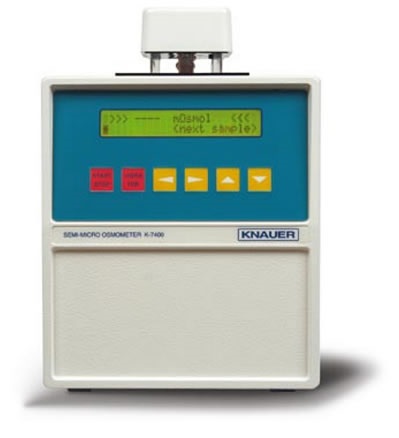M
0
[h=2]Introduction[/thanks]One of the most common medical problems in the area of ophthalmology is dry eye syndrome. The eyes usually become dry as a result of external influences such as air travel, air pollution, air conditioning and central heating. This often leads to the tear fluid losing liquid and becoming more concentrated. This article describes a simple and fast technique that can be used to ascertain the osmolarity of salt solutions for the preparation of eye drops.
[h=2]Osmotic Pressure[/thanks]Tear fluid has an osmotic pressure (owing to its colloid electrolyte content) that can be measured using the Pepper's cell technique. However, this technique is complicated and time consuming. The osmotic pressure is a colligative property and can be determined by quantifying the freezing point, which is relative to the osmotic pressure. A freezing point osmometer is used to determine the osmotic pressure and can be specified as osmolarity in mOsmol per liter (mOsmol/l).
In ophthalmic samples from healthy subjects, the tear film usually varies from 290 to 300m Osmol/l. As the osmolarity increases, the liquid content decreases. A severe decrease of the liquid content in tear fluid can permanently damage the eye.
In many publications, the following classification and limits can be found:
[h=2]Method Parameters and Sample Preparation[/thanks]

[h=2]Osmotic Pressure[/thanks]Tear fluid has an osmotic pressure (owing to its colloid electrolyte content) that can be measured using the Pepper's cell technique. However, this technique is complicated and time consuming. The osmotic pressure is a colligative property and can be determined by quantifying the freezing point, which is relative to the osmotic pressure. A freezing point osmometer is used to determine the osmotic pressure and can be specified as osmolarity in mOsmol per liter (mOsmol/l).
In ophthalmic samples from healthy subjects, the tear film usually varies from 290 to 300m Osmol/l. As the osmolarity increases, the liquid content decreases. A severe decrease of the liquid content in tear fluid can permanently damage the eye.
In many publications, the following classification and limits can be found:
- Values less than 308mOsmol/l are considered normal
- Values between 308–328mOsmol/l represent the range for mild to moderate dry eye
- Values higher than 328mOsmol/l indicate serious illness
[h=2]Method Parameters and Sample Preparation[/thanks]

Figure 1. KNAUER semi-micro osmometer K-7400
For the experimental analysis, the following apparatus and parameters are used:- Instrument:
- Sample tubes: Glass vials
- Sample volume: 150
